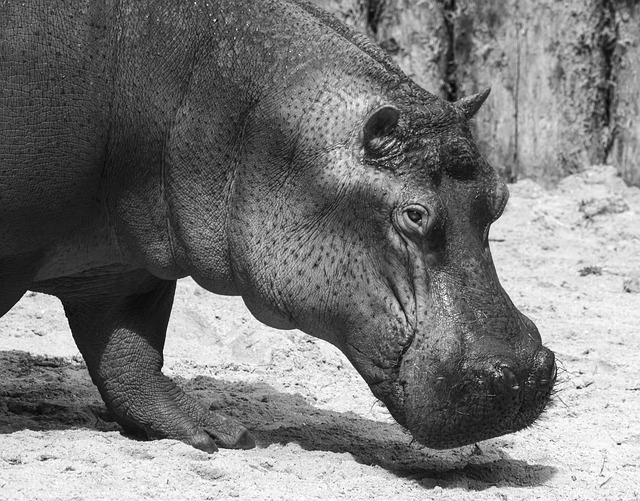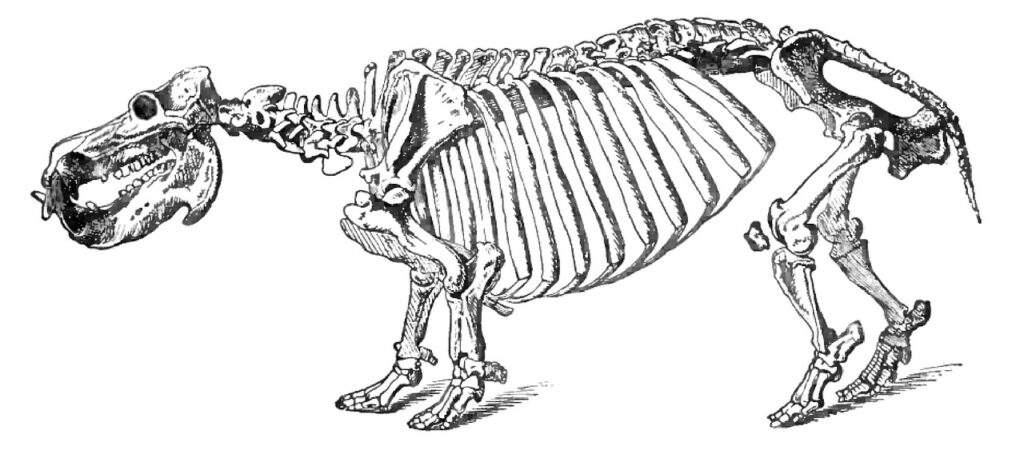Introduction: The Enigmatic Hippopotamus Skull
The Hippopotamus, or “river horse,” is a creature of immense intrigue and fascination, characterized by its massive size and formidable presence. Yet, perhaps one of the most captivating aspects of this behemoth mammal lies within its skull – a marvel of natural engineering that not only serves as a tool for survival but also holds a wealth of scientific insights and cultural significance.
Anatomy of Power: Understanding the Hippopotamus Skull
At first glance, the skull of a hippopotamus appears robust and imposing, reflecting the strength and resilience of this mighty creature. A closer examination reveals a myriad of features finely tuned for its aquatic lifestyle and territorial defense.
The most striking aspect of the hippopotamus skull is its sheer size, which accounts for a significant portion of its total body mass. This bulk serves not only as a protective barrier but also as a mechanism for buoyancy, allowing the hippo to effortlessly navigate through the waterways it calls home.
The formidable tusks that protrude from the hippo’s mouth are another defining feature of its skull. These elongated incisors can grow up to 50 centimeters in length and are used primarily for combat and display. Despite their imposing appearance, these tusks are not used for feeding but rather serve as potent weapons in territorial disputes and mating rituals.
Adaptations for Aquatic Life:

Unlike most mammals, hippos spend the majority of their lives submerged in water, emerging only to feed or bask in the sun. As such, their skulls have evolved a series of adaptations to suit this unique lifestyle.
One such adaptation is the positioning of the nostrils, which are located high on the skull to allow the hippo to breathe while submerged. This clever design enables the hippo to remain submerged for extended periods without the need to resurface, giving it a distinct advantage over its terrestrial counterparts.
Furthermore, the hippopotamus skull boasts a set of specialized valves and muscles that allow it to close off its ears and nostrils while submerged, preventing water from entering and facilitating efficient diving. These adaptations highlight the remarkable versatility of the hippo’s skull and its ability to thrive in its aquatic habitat.
Cultural Significance and Symbolism:
Throughout history, the hippopotamus has held a prominent place in the mythology and symbolism of various cultures around the world. In ancient Egypt, the hippopotamus was revered as a symbol of fertility and rebirth, often depicted in religious iconography and funerary art. The goddess Taweret, often depicted as a hippopotamus, was believed to protect women during childbirth and ward off evil spirits.
Similarly, in African folklore, the hippopotamus is often portrayed as a powerful and enigmatic creature, embodying both the forces of creation and destruction. Its presence in traditional rituals and ceremonies reflects the deep-seated respect and awe that indigenous cultures hold for this magnificent animal.
Conservation Challenges and Future Prospects:
Despite its revered status in folklore and mythology, the hippopotamus faces numerous threats to its survival in the wild. Habitat loss, poaching, and human-wildlife conflict pose significant challenges to hippo populations across Africa, leading to a steady decline in numbers in recent decades.

Efforts to conserve the hippopotamus and its habitat are underway, with initiatives aimed at mitigating human-wildlife conflict, protecting critical habitats, and raising awareness about the importance of preserving these iconic animals for future generations. By addressing these challenges and implementing sustainable conservation strategies, we can ensure the long-term survival of the hippopotamus and safeguard its place in the natural world.
Conclusion: Unlocking the Secrets of Nature’s Architectural Wonder
In conclusion, the hippopotamus skull stands as a testament to the ingenuity and adaptability of the natural world. From its formidable size and strength to its intricate adaptations for aquatic life, the hippo’s skull is a marvel of evolutionary engineering that continues to inspire awe and fascination.
Moreover, the cultural significance and symbolism surrounding the hippopotamus serve as a poignant reminder of humanity’s deep connection to the natural world and the importance of preserving its biodiversity for future generations.
As we strive to protect and conserve the hippopotamus and its habitat, let us also take a moment to marvel at the beauty and complexity of nature’s architectural wonders, and the profound impact they have on our lives and imaginations.
Unveiling the Mystique of the Hippopotamus Skull: A Journey into Nature’s Architectural Wonder
Exploring Functional Adaptations:
Delving deeper into the functional adaptations of the hippopotamus skull unveils a myriad of evolutionary marvels. One such adaptation is the unique structure of the jaw, which allows the hippo to exert tremendous biting force. This remarkable feature enables the hippopotamus to crush through tough vegetation with ease, sustaining its herbivorous diet of grasses and aquatic plants.

Furthermore, the skull’s thick, dense bone structure serves as a formidable defense against predators and rivals. Combined with the protective layer of keratin that covers the tusks, the hippo’s skull becomes virtually impervious to external threats, ensuring its survival in the harsh and unforgiving environments it inhabits.
Evolutionary Insights and Scientific Inquiry:
Beyond its functional adaptations, the hippopotamus skull provides invaluable insights into the evolutionary history of this iconic species. Comparative studies of hippo skulls have revealed intriguing similarities with their ancient ancestors, shedding light on the evolutionary processes that have shaped their morphology over millions of years.
Moreover, advances in modern imaging techniques, such as CT scanning and 3D modeling, have enabled scientists to peer inside the intricacies of the hippopotamus skull with unprecedented detail. These technological advancements have yielded groundbreaking discoveries about the biomechanics of hippo jaws, the development of their sensory organs, and the intricacies of their cranial anatomy.
As we continue to unlock the mysteries of this enigmatic creature, let us not forget the profound responsibility we bear to safeguard its future and preserve its place in the tapestry of life. For in the majestic contours of the hippopotamus skull, we find not only a testament to the past but also a beacon of hope for the future of our planet and all its inhabitants.
FAQS:
Hippo skulls are massive, reflecting the animal that they came from. A standard specimen is 2 ft 3 inches long, 1 ft 6 inches wide, and 1 ft 8 inches high. While there isn’t any specific information on the exact weight of a hippo head, we can assume it’s a few hundred pounds fully fleshed.
The exact number of bones that hippos have is unknown.
With a body this heavy it might be surprising to learn that it is supported by relatively thin leg bones. However, these leg bones are extremely dense, with little porous material like other bones.
Parts of the appendicular skeleton of hippos are osteosclerotic, meaning that their bones are extraordinarily dense due to the replacement of porous bone with more compact bone.
Pachycephalosaurus is famous for having a large, bony dome on top of its skull, up to 25 cm (10 in) thick, which safely cushioned its brain.
The largest land animal skull ever found measures 3.2 m in height (10 ft 6 in) and belongs to the skeleton of a Pentaceratops dinosaur.
They have one of the most powerful jaws in the animal kingdom, capable of crushing bones and even small boats! So, if a hippo were to bite you, it could cause severe injuries. In the wild, it’s best to keep a safe distance from these magnificent creatures and admire them from afar.
The hippo brain weighs 600 grams; the elephant brain weighs about 6000 grams, 10x as much. The elephant is much smarter than a hippo.




